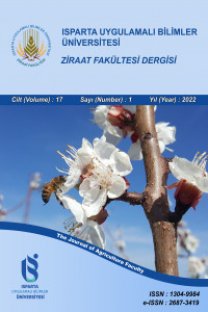Changes on Soil Biological Activity With Respect To Irrigation, Mulch and Calcium Application
Mulching, water stress, droght, soil microbiology
Changes on Soil Biological Activity With Respect To Irrigation, Mulch and Calcium Application
___
- Bek Y., 1983. Research and Experimental Methods. Cukurova University. Agriculture Faculty Lecture, 92, Adana.
- Bouyoucos G.J., 1951. A recalibration of the hydrometer method for making mechanical analysis of soils. Agronomy Journal 43: 434-438.
- Caglar, K.O., 1949. Soil Science. University of Ankara, Agricultural Faculty Press Nr 10, p 230 (in Turkish).
- Derartu Wodajo, D., 2015. Effects of compost application rates and mulch thickness on tomato (Solanum lycopersicum L.) Yield, quality and soil physicochemical properties under salt affected soil of dugda district of oramia region. Msc. Thesis. Jimma University. P.1-10. Ethiopia.
- Dick, W.A. and M.A. Tabatabai, 1993. Significance and potential uses of soil enzymes, pp: 95-127, In B. Metting (ed.), Soil Microbial Ecology, Marcel Dekker, New York.
- Dogan, K., Sariyev, A., Gok, M., Coskan, A., Tulun, Y., Sesveren, S., 2013. Effect of solarization under different applications on soil temperature variation and microbial activity. J. Food Agric. Environ. 11, 329–332.
- Isermayer H., 1952. Eine Einfache Methode zur Bestimmung der Bodenatmung und der Karbonate im Boden. Z. Pflanzenernehr. Bodenkd. S 56.
- Kahlon, M.S. and R. Lal, 2011. Enhancing green water in soils of South Asia. J. Crop Imp. 25: 101–133.
- Katan, J., Greenberger, A., Laon, H., Grinstein, A., 1976. Solar heating by polyethtlene mulching for the control of diseases caused by soilborne pathogens. Phytopathology 66, 683–688.
- Kumar, S., Chaudhuri S. and. Maiti, S.K., 2013. Soil Dehydrogenase Enzyme Activity in Natural and Mine Soil. Middle-East Journal of Scientific Research 13 (7): 898-906, 2013.
- Ohlinger R., 1993. Bestimmung des BiomasseKohlenstoffs mittels Fumigation-Exstraktion. In:Schinner, F., Ohlinger, R., Kandler, E., Margesin, R. (eds.). Boden biologische Arbeits methoden. 2. Auflage. Springer Verlag. Berlin, Heidelberg.
- Oz H., Coskan A., Atilgan A. 2016, Effect of different plastic cover materials and biofumigation to soil organic matter decomposition in greenhouse solarization. Scientific Papers. Series A. Agronomy, Vol. LIX, ISSN 2285-5785, 127-129.
- Pahlow, M., Krol, M.S., Hoekstra, A.Y., 2015. Assessment of measures to reduce the water Footprint of cotton farming in india. Value of water research report series no. 68. Twente. P. 1-14.
- Schlichting E., Blume E., 1966. Bodenkundliches Prakticum. Paul Parey Verlag, Hamburg, Berlin.
- Stapleton, J.J., 2000. Soil solarization in various agricultural production systems. Crop Protection 19, 837–841.
- Steinmetz, Z., Wollmann, C., Schaefer, M., Buchmann, C., David, J., Tröger, J., Muñoz, K., Frör, O., Schaumann, G.E., 2016. Plastic mulching in agriculture. Trading short-term agronomic benefits for long-term soil degradation?. Science of the Total Environment 550 (2016) 690–705
- Thalman A., 1967. Uber die mikrobielle Aktivitaet und ihre Beziehungen zur Fruchtbarkeitsmerkmalen einiger Ackerboden unter besonderer Berücksichtigung der Dehydrogenase aktivitaet (TTC-Reduktion) Diss. Giessen (FRG).
- U.S. Salinity laboratory staff, 1954. Diagnosis and Improvement of Saline and Alkaline Soils, USDA No: 6.
- Wild A., 1993. Soils and Environment: An Introduction. Cambridge, UK: Cambridge University. Press. 287 p
- ISSN: 1304-9984
- Yayın Aralığı: Yılda 2 Sayı
- Başlangıç: 2006
- Yayıncı: Isparta Uygulamalı Bilimler Üniversitesi
Sedat BOYACI, Gökhan FİLİK, Ayşe Gül FİLİK
Hayvancılık İşletmelerinde Endüstriyel Simbiyoz Uygulaması: Bursa Örneği
İlker KILIÇ, Hatice DELİCE, Sinem SOFU, Burak YILDIZ
Nada JOUMA, Filiz DADASER CELIK
Zafer Ali SERBEŞ, Umut OKKAN, Şerafettin AŞIK
Naciye Aygen ÖZHAN, Kenan BÜYÜKTAŞ, Ahmet TEZCAN
Arazi Toplulaştırma Projelerinin Kırsal Alanlarda Yakıt Giderlerine Ve Modern Tarıma Etkisi
Arazi Toplulaştırma Projelerinde Yol Uzunluklarının Analizi: Şanlıurfa Türkeli Köyü Örneği
Hamza KUZU, Fırat ARSLAN, Hasan DEĞİRMENCİ
Changes on Soil Biological Activity With Respect To Irrigation, Mulch and Calcium Application
Kemal DOĞAN, Sefer BOZKURT, Ali SARIOĞLU, Necat AĞCA, Ekin ŞAKAR
Sema KALE ÇELİK, Ufuk TÜRKER, Sevinç MADENOĞLU, Bülent SÖNMEZ
